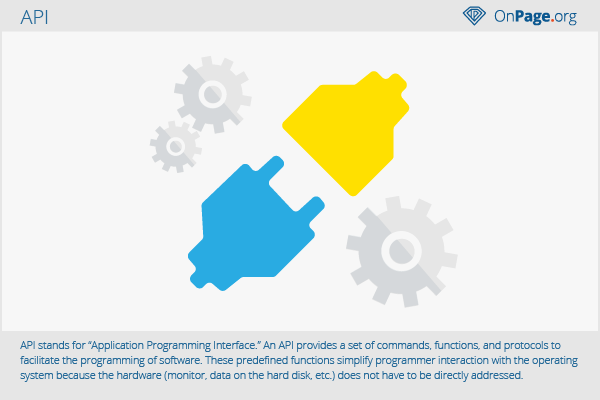API
API stands for “Application Programming Interface.” An API provides a set of commands, functions, and protocols to facilitate the programming of software. These predefined functions simplify programmer interaction with the operating system because the hardware (monitor, data on the hard disk, etc.) does not have to be directly addressed. With regard to the Internet, Web APIs are at the forefront and they also serve as an interface to allow the use of existing functions from third parties.
Web API
Since the times of Web 2.0, the term API has been mentioned increasingly in connection with the Internet. A web API is an interface for web pages and web applications. It is used in the exchange and processing of content between websites and allow third parties to access data pools and user circles. The authorization API and the authentication API are two special types of web APIs.
- Authorization API: Interface to grant access to users. The OAuth standard has been established here. A user can independently agree to make his data accessible to third parties via APIs. An example are external applications that post tweets in the user’s name.
- Authentication API: An interface to authenticate users. A user can be identified on a platform on which he does not have a personal account. Instead, the authentication is done in collaboration with an authorization API via a webpage to which the user is actually logged in. The best example is Facebook Connect.
Declaration based on Google APIs
The Google search engine provides many APIs as part of its services. This allows other websites to pass Google services directly to their visitors without the Google website being retrieved. One example is Google Maps. A restaurant may include on its website a section of Google Maps, where the location of the restaurant is marked. This is possible because Google provides “Google Maps Image APIs.”[1]. These APIs are the interface between the Google Maps service and any other website that use the APIs.
Another simple example is the YouTube service and the YouTube API.[2] It enables the integration of YouTube videos on any website. Webmasters can use the external service on their own website and make it available to their visitors through the interface provided.
Google offers a Google Webmaster Tool API for search engine optimization. It allows webmasters who want to write their own tools to access data such as the keywords of search queries.[3] Programmers can write applications themselves because they have access to the required data through the interface.
Many of these APIs can be used free of charge, only a few fee-based.
References
Web Links
- http://www.techterms.com/definition/api
- http://www.webopedia.com/TERM/A/API.html
- https://developers.google.com/maps/

